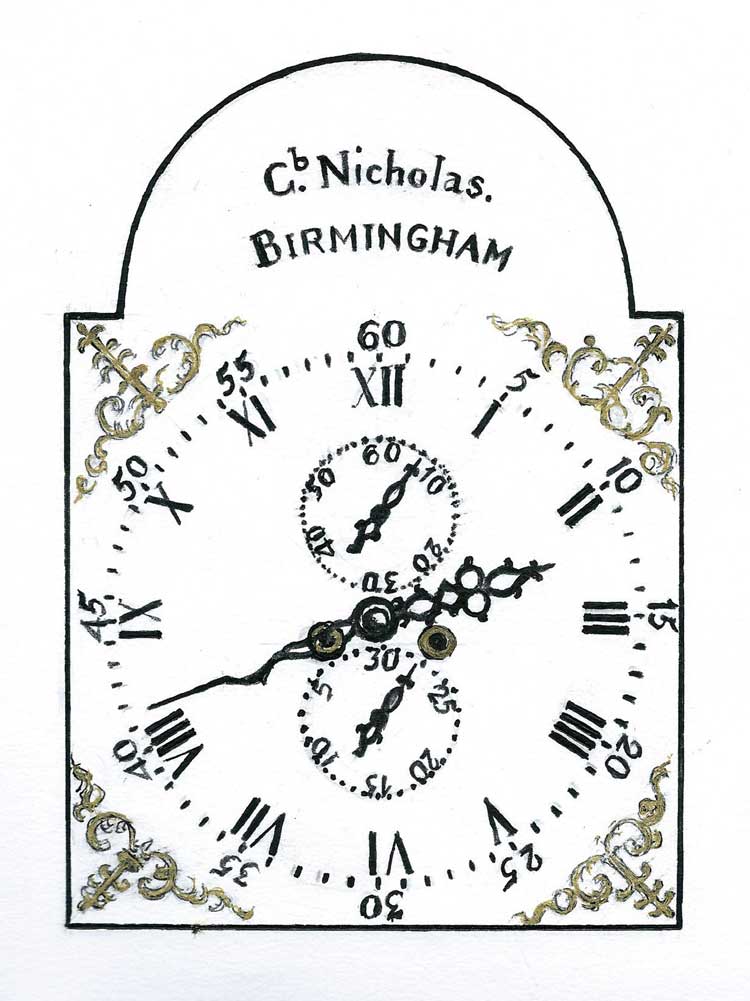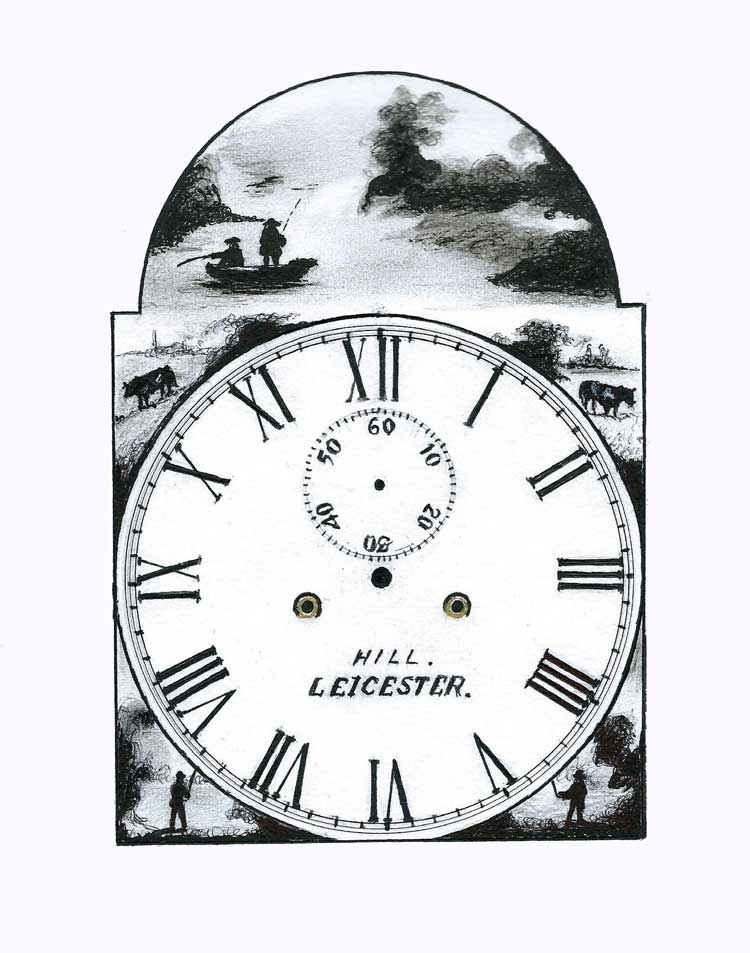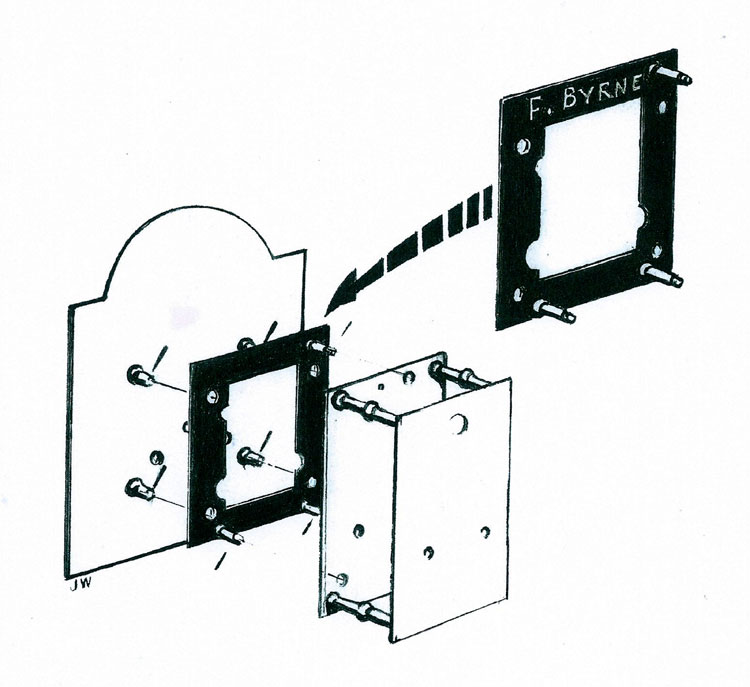White Japanned Clock Dials
This paper is a brief history of the White Japanned Clock Dial and its manufacture for about a century, predominantly in Birmingham.
Everyone is familiar with the so called “Grandfather Clock”, more accurately called a longcase clock, and the white faced dial that is often an accompanying feature. White dials, sometimes referred to incorrectly as “enamel” dials, were manufactured in extremely large numbers employing the japanning process. Japanning consists of laying a coat of paint on to a sheet of metal, usually iron, and subjecting it to heat in an oven or kiln. Enamelling is very different to japanning and involves the fusing of special paints, usually on to a copper substrate, at elevated temperatures (red heat) to produce an opaque glass-like structure. The enamelling process was usually confined to small objects, such as snuff boxes, vanity boxes and similar items but did not include, in the vast majority of cases, clock dials. It is technically quite difficult to truly enamel large flat surfaces. A great deal of japanning in the eighteenth and nineteenth centuries took place in Birmingham. Battersea and Bilston were the main centres of enamelling in the eighteenth and nineteenth centuries.
The dial of a traditional English longcase clock, right from its inception in the mid seventeenth century, was usually made from a single sheet of brass onto which various additional items such as decorative spandrels, chapter rings, seconds rings, calendar wheels and other features were affixed. The chapter ring, on which the numerals were engraved and subsequently filled with black wax, was invariably “silvered” to enhance its overall clarity. An area of the dial contained within the chapter ring was often “matted”. “Matting” consisted of using a special matting punch and hammer to evenly cover the surface of the brass with a myriad number of small indentations to give an attractive and uniform satin-like finish. The excellence of the matting is often an indicator of the overall quality of the clock. Clocks by the great masters such as Thomas Tompion, Joseph Knibb, Joseph Windmills, Daniel Quare, George Graham, et al, invariably feature fine quality matting.
In about 1770, or shortly afterwards, a person or a group of persons introduced the white dial clock. It was a novelty that would eventually sweep away the brass faced clock dial almost completely. The white dial possessed several advantages over its brass equivalent, including clarity of display, relative cheapness of manufacture and the ability to be attached to any weight driven longcase clock movement of eight day or thirty hours duration. These features permitted the white dial itself to become a factory made item, but still capable of being supplied to individual craftsmen clockmakers throughout the country. Although the dials were now factory made and decorated it did not necessarily imply that the movements themselves, still made by the same skilled craftsmen clockmakers, had degenerated or were in any way inferior to their predecessors, at least not initially.
On any normal English 8 day longcase clock, whether they be brass or white dial, there are a number of features that must align between the dial and movement. These include the two winding holes in the dial that must exactly match respectively the going and striking train winding arbors on the clock. Similarly the hands pipe on the clock must be capable of passing through the dial at the appropriate position. Additionally, a seconds hand arbor and perhaps a calendar indicator arbor may also have to pass through the dial. All these requirements had to be taken into account by the clockmaker when laying out the clock’s dimensions, although many of these would have been pretty much standard. However, to further assist the clockmaker in the fitting of his clock to the new factory made white dial, a simple but neat solution was contrived.
The neat solution was the falseplate. There is every reason to believe that the falseplate was an integral part of the white dial right from its inception and was supplied with it. The falseplate was a subsidiary plate that fitted between the rear face of the dial and the front plate of the clock. It was, to use modern terminology, “an interface”. At the rear of most 8 day white dials supplied with a falseplate were four short dial feet, which located into the falseplate, retention being made by taper pins. Riveted into the falseplate itself there were usually three slightly longer projecting feet that were designed to locate into the front plate of the clock; again retention was obtained using taper pins. The clockmaker therefore had a greater degree of latitude, provided by the falseplate, in the positioning of his clock into the factory made dial. Falseplates could also be modified by the clockmaker to provide any necessary clearances as demanded by the movement. Thirty hour clock movements did not require falseplate dials as there were fewer things to align, generally only a single hole for the hands pipe. See Fig.1
Brian Loomes in his authoritative book, The White Dial Clock, states that the first documented reference relating to a white dial manufacturer appears in the Birmingham Gazette of 28th September 1772. The reference concerns an advertisement placed by the manufacturers Osborne and Wilson, describing the opening of their new warehouse at 3 Colmore Row, Birmingham. However, the partnership between Thomas Hadley Osborne and James Wilson only lasted 5 years, and the public notification of their business separation appeared in the Birmingham Gazette for 29th September 1777. Both men continued thereafter in the white dial trade, apparently as rivals. Thomas Hadley Osborne died in 1779 and his business was taken over by his widow, Ann. Wilson’s company was probably the more prosperous of the two and seems to have continued until his death in 1809.
These two pioneering Birmingham dial makers were soon joined by many others; Loomes lists 68 more in Birmingham alone, spanning the entire white dial period of manufacture. Some of these of course may have been businesses that slightly changed their names over time, perhaps due to sons’ taking over from their fathers, etc, and could be considered as duplication. Nevertheless it is still a formidable number. Interestingly, one name on the list, that of Finnemore, is still an active company in the Birmingham Jewellery Quarter. Whilst Birmingham was overwhelmingly the main centre for white dial manufacture, a limited amount of production seems to have also been carried out in Halifax, Leeds and perhaps Newcastle upon Tyne.
Manufacturers of white dials usually applied their names to the rear face of the dial and frequently on the falseplate too. Occasionally there are no markings at all. It has been suggested that where this is the case it may be due to the markings being under the japanned surface and therefore not visible. This is entirely plausible as in all probability the operatives who applied the paint prior to japanning were not too bothered to which surface it was applied!
White dials were manufactured in various shapes and sizes; square, arched, circular and elliptical, the latter being the least common. They also could have all the elements of a brass dial, including moon phases, strike/silent features, calendar indicators, seconds hands and occasionally automata (rocking ships, windmills, see-saws, Eve proffering an apple, moving eyes, etc,).
There were three distinct phases of English white dial clock decoration, although of course there were degrees of overlap between each phase. Stylistic changes in casework also went in parallel with dial progression.
1) The earliest phase from about 1770 to 1800 was the perhaps the finest, with the decoration of the dial fairly sparse but very tastefully carried out, often with considerable skill. The style of decoration would be typically “swags and tags” or other Georgian motifs. The painted hour numerals were Roman and of rather small size. Clock cases accompanying these dials were generally elegant and well proportioned, tall and slender with doors the full length of the carcase. See Fig.2

2) From about 1800 there were stylistic changes. The decoration of the dial was still of high quality, but more comprehensive than phase 1; an arch dial for example may contain a vignette or perhaps a pastoral scene, which was usually well executed. The hour numerals changed from Roman to Arabic style. The cases associated with this stage of dial development were still fairly well proportioned but suffered a little in comparison with phase 1. The case doors were somewhat reduced in length. See Fig.3
3) The third phase commenced about 1825 and continued right to the end of the white dial clock era in the 1870s. The dials tended to be of a larger size, becoming progressively subsumed in a riot of decoration as befitted high Victorian taste, with the execution perhaps to a slightly lower standard than phases 1&2. The hour numerals reverted to Roman type, although of a larger size than in phase 1 above. There was now a tendency for clock movements to be factory made, obviating the need for falseplates. See Fig. 4

Clock cases had also progressively grown in size, becoming almost elephantine. Case proportions had completely degenerated, losing all semblance of elegance manifested in phases 1&2. Nevertheless, the quality of cabinet making was of a high order, with expensive veneers, inlays, stringing, etc, being used. Clocks of this era would perhaps not be to everyone’s taste today, although they do have their adherents, particularly in some European countries, notably the Netherlands and Sweden.
The white dial was also exported in large numbers, particularly to the eastern seaboard communities of America. It highly probable that many of the early American clockmakers were of British stock and took their skills and affiliations from the old country to the new. One noted authority on the subject has stated that white dials were not made in America until after 1800. American longcase clocks (“tall clocks” in American parlance) of the Georgian period can be particularly elegant, with fine casework.
The white dial has been a long lived and very durable object, some examples now being nearly two hundred and fifty years old. Their survival is truly remarkable. Unfortunately, many longcase clocks and their associated white dials succumbed not so much to deterioration and decay but more to the fickle whims of popular taste; this was particularly so in the post war years when the longcase clock became very unloved. Many clocks were literally cast aside as not being compatible with the “new look” Swedish style “stick” furniture. Fortunately, the situation has changed considerably, despite the current trend to “minimalism”, and longcase clocks are much more appreciated today than yesteryear. Long may this situation continue.
The author would like to thank Michael Doody and the WIAS webmaster for their kind assistance in the preparation of this paper.
Copyright © J F Willock February 2022
All drawings by the author
References
- The White Dial Clock, Brian Loomes, David and Charles, Newton Abbot, 1974
- Complete British Clocks, Brian Loomes, David and Charles, Newton Abbot, 1978
- Longcase Painted Dials, Their History and Restoration, M F Tennant, NAG Press, Robert Hale, London, 1995
- Old Clocks, H. Alan Lloyd, Ernest Benn, London, 1964 (Third Ed.)


